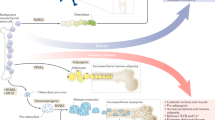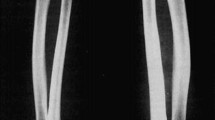Abstract
Exercise is effective in promoting bone health because skeletal cells are highly mechanosensitive. The bone cell population can sense and respond to mechanical perturbations induced by exercise, and generate signals that ultimately result in a more mechanically competent skeleton. A number of factors affect bone tissue’s ability to respond appropriately to exercise/loading. These are important considerations in a clinical context, where the positive effects of mechanotransduction can be harnessed to improve outcomes and prevent future fractures. Recovery periods and cellular saturation are important factors when designing and implementing exercise sessions, as these phenomena can affect the efficiency of bone gain. Other factors include the cellular effects of aging, and the hormonal milieu, both of which can modify the responsiveness of bone cells to strain stimuli. Many medications can affect the cellular processes associated with mechanical signaling in bone cells. Though not well studied, it is possible that the effects of exercise on the skeleton can be compromised in patients who are prescribed many of these agents, including calcium channel blockers, NSAIDS, and nitric oxide inhibitors. As the cellular and molecular mechanisms involved in bone cell mechanotransduction become better defined, new targets for therapeutic intervention will be identified. As these pathways become more thoroughly characterized, it might be possible to trigger the signaling cascades activated by mechanical loading without applying any force to the bone. This would be particularly useful for patients in whom exercise would be beneficial to bone health, but have skeletal properties that would put them at too great a risk for fracture if exercise protocols were introduced.
The present invited review was completed and submitted to the publisher on 20-Sep-19.
Access this chapter
Tax calculation will be finalised at checkout
Purchases are for personal use only
Similar content being viewed by others
References
Vandenbrink JP, Kiss JZ. Plant responses to gravity. Semin Cell Dev Biol. 2019;92:122–5.
Buenzli PR, Sims NA. Quantifying the osteocyte network in the human skeleton. Bone. 2015;75:144–50.
Palumbo C, Ferretti M, Marotti G. Osteocyte dendrogenesis in static and dynamic bone formation: an ultrastructural study. Anat Rec A Discov Mol Cell Evol Biol. 2004;278(1):474–80.
Tatsumi S, Ishii K, Amizuka N, Li M, Kobayashi T, Kohno K, Ito M, Takeshita S, Ikeda K. Targeted ablation of osteocytes induces osteoporosis with defective mechanotransduction. Cell Metab. 2007;5(6):464–75.
Inaoka T, Lean JM, Bessho T, Chow JW, Mackay A, Kokubo T, Chambers TJ. Sequential analysis of gene expression after an osteogenic stimulus: c-fos expression is induced in osteocytes. Biochem Biophys Res Commun. 1995;217(1):264–70.
Lara-Castillo N, Kim-Weroha NA, Kamel MA, Javaheri B, Ellies DL, Krumlauf RE, Thiagarajan G, Johnson ML. In vivo mechanical loading rapidly activates beta-catenin signaling in osteocytes through a prostaglandin mediated mechanism. Bone. 2015;76:58–66.
Hert J, Liskova M, Landrgot B. Influence of the long-term, continuous bending on the bone. An experimental study on the tibia of the rabbit. Folia Morphol (Praha). 1969;17(4):389–99.
Liskova M, Hert J. Reaction of bone to mechanical stimuli. 2. Periosteal and endosteal reaction of tibial diaphysis in rabbit to intermittent loading. Folia Morphol (Praha). 1971;19(3):301–17.
Turner CH, Forwood MR, Otter MW. Mechanotransduction in bone: do bone cells act as sensors of fluid flow? FASEB J. 1994;8(11):875–8.
Warden SJ, Turner CH. Mechanotransduction in the cortical bone is most efficient at loading frequencies of 5-10 Hz. Bone. 2004;34(2):261–70.
Rubin CT, McLeod KJ. Promotion of bony ingrowth by frequency-specific, low-amplitude mechanical strain. Clin Orthop Relat Res. 1994;298:165–74.
Blottner D, Salanova M, Puttmann B, Schiffl G, Felsenberg D, Buehring B, Rittweger J. Human skeletal muscle structure and function preserved by vibration muscle exercise following 55 days of bed rest. Eur J Appl Physiol. 2006;97(3):261–71.
Ward K, Alsop C, Caulton J, Rubin C, Adams J, Mughal Z. Low magnitude mechanical loading is osteogenic in children with disabling conditions. J Bone Miner Res. 2004;19(3):360–9.
Oliveira LC, Oliveira RG, Pires-Oliveira DA. Effects of whole body vibration on bone mineral density in postmenopausal women: a systematic review and meta-analysis. Osteoporos Int. 2016;27(10):2913–33.
O’Connor JA, Lanyon LE, MacFie H. The influence of strain rate on adaptive bone remodelling. J Biomech. 1982;15(10):767–81.
Turner CH, Owan I, Takano Y. Mechanotransduction in bone: role of strain rate. Am J Phys. 1995;269(3 Pt 1):E438–42.
Mosley JR, Lanyon LE. Strain rate as a controlling influence on adaptive modeling in response to dynamic loading of the ulna in growing male rats. Bone. 1998;23(4):313–8.
Nikander R, Kannus P, Rantalainen T, Uusi-Rasi K, Heinonen A, Sievanen H. Cross-sectional geometry of weight-bearing tibia in female athletes subjected to different exercise loadings. Osteoporos Int. 2010;21(10):1687–94.
Ma D, Wu L, He Z. Effects of walking on the preservation of bone mineral density in perimenopausal and postmenopausal women: a systematic review and meta-analysis. Menopause. 2013;20(11):1216–26.
Zhao R, Zhao M, Zhang L. Efficiency of jumping exercise in improving bone mineral density among premenopausal women: a meta-analysis. Sports Med. 2014;44(10):1393–402.
Marques EA, Mota J, Carvalho J. Exercise effects on bone mineral density in older adults: a meta-analysis of randomized controlled trials. Age (Dordr). 2012;34(6):1493–515.
Martyn-St James M, Carroll S. A meta-analysis of impact exercise on postmenopausal bone loss: the case for mixed loading exercise programmes. Br J Sports Med. 2009;43(12):898–908.
Rubin CT, Lanyon LE. Regulation of bone formation by applied dynamic loads. J Bone Joint Surg Am. 1984;66(3):397–402.
Umemura Y, Ishiko T, Yamauchi T, Kurono M, Mashiko S. Five jumps per day increase bone mass and breaking force in rats. J Bone Miner Res. 1997;12(9):1480–5.
Turner CH. Three rules for bone adaptation to mechanical stimuli. Bone. 1998;23(5):399–407.
Forwood MR, Turner CH. The response of rat tibiae to incremental bouts of mechanical loading: a quantum concept for bone formation. Bone. 1994;15(6):603–9.
Srinivasan S, Weimer DA, Agans SC, Bain SD, Gross TS. Low-magnitude mechanical loading becomes osteogenic when rest is inserted between each load cycle. J Bone Miner Res. 2002;17(9):1613–20.
Robling AG, Burr DB, Turner CH. Recovery periods restore mechanosensitivity to dynamically loaded bone. J Exp Biol. 2001;204(Pt 19):3389–99.
Robling AG, Hinant FM, Burr DB, Turner CH. Improved bone structure and strength after long-term mechanical loading is greatest if loading is separated into short bouts. J Bone Miner Res. 2002;17(8):1545–54.
Robling AG, Hinant FM, Burr DB, Turner CH. Shorter, more frequent mechanical loading sessions enhance bone mass. Med Sci Sports Exerc. 2002;34(2):196–202.
Saxon LK, Robling AG, Alam I, Turner CH. Mechanosensitivity of the rat skeleton decreases after a long period of loading, but is improved with time off. Bone. 2005;36(3):454–64.
Rubin CT, Bain SD, McLeod KJ. Suppression of the osteogenic response in the aging skeleton. Calcif Tissue Int. 1992;50(4):306–13.
Srinivasan S, Ausk BJ, Prasad J, Threet D, Bain SD, Richardson TS, Gross TS. Rescuing loading induced bone formation at senescence. PLoS Comput Biol. 2010;6(9):e1000924.
Turner CH, Takano Y, Owan I. Aging changes mechanical loading thresholds for bone formation in rats. J Bone Miner Res. 1995;10(10):1544–9.
Manolagas SC, Parfitt AM. What old means to bone. Trends Endocrinol Metab. 2010;21(6):369–74.
Frost HM. Bone “mass” and the “mechanostat”: a proposal. Anat Rec. 1987;219(1):1–9.
Robling AG, Fuchs RK, Burr DB. Mechanical adaptation of bone. In: Burr DB, Allen MR, editors. Basic and applied bone biology. New York: Elsevier; 2013. p. 175–204.
Lee K, Jessop H, Suswillo R, Zaman G, Lanyon L. Endocrinology: bone adaptation requires oestrogen receptor-alpha. Nature. 2003;424(6947):389.
Moura MLA, Fugimoto M, Kawachi APM, de Oliveira ML, Lazaretti-Castro M, Reginato RD. Estrogen therapy associated with mechanical vibration improves bone microarchitecture and density in osteopenic female mice. J Anat. 2018;233(6):715–23.
Thorsen K, Kristoffersson AO, Lerner UH, Lorentzon RP. In situ microdialysis in bone tissue. Stimulation of prostaglandin E2 release by weight-bearing mechanical loading. J Clin Invest. 1996;98(11):2446–9.
Li J, Burr DB, Turner CH. Suppression of prostaglandin synthesis with NS-398 has different effects on endocortical and periosteal bone formation induced by mechanical loading. Calcif Tissue Int. 2002;70(4):320–9.
Kohrt WM, Barry DW, Van Pelt RE, Jankowski CM, Wolfe P, Schwartz RS. Timing of ibuprofen use and bone mineral density adaptations to exercise training. J Bone Miner Res. 2010;25(6):1415–22.
Sherk VD, Carpenter RD, Giles ED, Higgins JA, Oljira RM, Johnson GC, Mills S, Maclean PS. Ibuprofen before exercise does not prevent cortical bone adaptations to training. Med Sci Sports Exerc. 2017;49(5):888–95.
Turner CH, Takano Y, Owan I, Murrell GA. Nitric oxide inhibitor L-NAME suppresses mechanically induced bone formation in rats. Am J Phys. 1996;270(4 Pt 1):E634–9.
Li J, Duncan RL, Burr DB, Turner CH. L-type calcium channels mediate mechanically induced bone formation in vivo. J Bone Miner Res. 2002;17(10):1795–800.
Brown GN, Leong PL, Guo XE. T-Type voltage-sensitive calcium channels mediate mechanically-induced intracellular calcium oscillations in osteocytes by regulating endoplasmic reticulum calcium dynamics. Bone. 2016;88:56–63.
Summary
The mechanical regulation of bone tissue is a potent mechanism that fine-tunes skeletal size, structure, and strength to meet the demands of everyday use. A greater understanding of the intricacies of mechanical signaling in bone cells will facilitate the use of these inherent mechanisms (e.g., mechanical energy profile, saturation and recovery, biochemical signaling cascades) to be harnessed to improve bone properties, reduce fracture risk, and promote skeletal rehabilitation after injury. As progress is made on the molecular biology of bone cells—particularly osteocytes—it is likely that clues to enhancing the osteogenic effects of exercise will emerge. Each year, more and more compounds targeting a greater breadth of cellular products achieve approval for clinical use; perhaps a small fraction, or some already available, can be repurposed to synergize with exercise to maximize bone health. Only after a more complete understanding of bone cell mechanotransduction will those insights be possible.
Author information
Authors and Affiliations
Corresponding author
Editor information
Editors and Affiliations
Rights and permissions
Copyright information
© 2022 Springer Nature Singapore Pte Ltd.
About this chapter
Cite this chapter
Robling, A.G. (2022). Bone Tissue and Its Mechanical Regulation of Remodeling. In: Takahashi, H.E., Burr, D.B., Yamamoto, N. (eds) Osteoporotic Fracture and Systemic Skeletal Disorders. Springer, Singapore. https://doi.org/10.1007/978-981-16-5613-2_2
Download citation
DOI: https://doi.org/10.1007/978-981-16-5613-2_2
Published:
Publisher Name: Springer, Singapore
Print ISBN: 978-981-16-5612-5
Online ISBN: 978-981-16-5613-2
eBook Packages: MedicineMedicine (R0)




